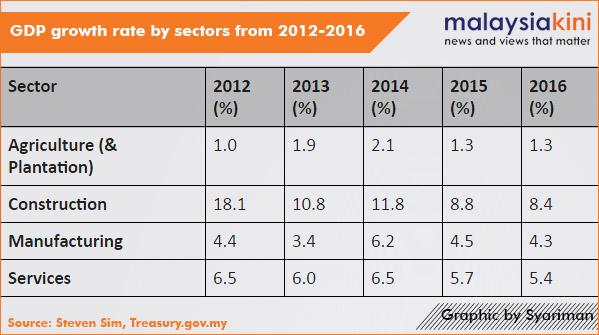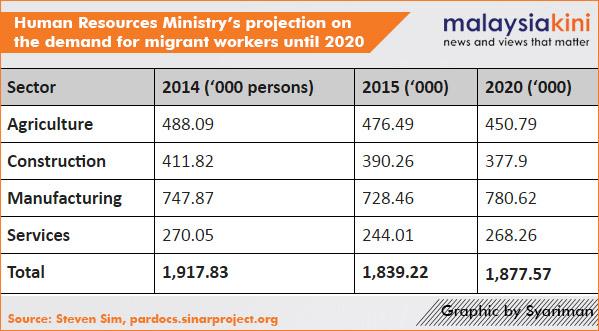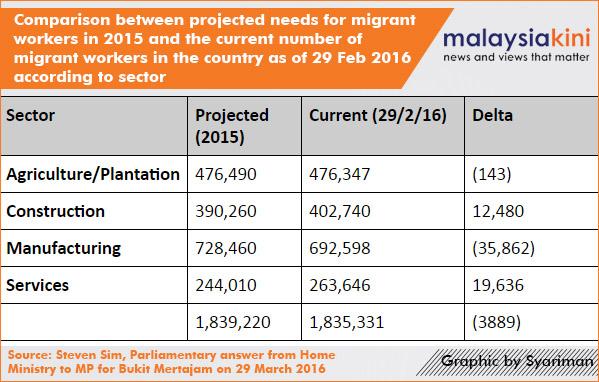MP SPEAKS I refer to a news report that the federal government has lifted the migrant workers recruitment moratorium for four industries, namely manufacturing, construction, plantation and furniture making.
I had said earlier that the government’s migrant workers policy is “disorganised, haphazard, random and senseless” and that the flip-flop on the moratorium is not only a reflection on such policy but it is also to hold the industry hostage to force the industry to 1) accept the 1.5 million Bangladeshi workers and 2) to accept the government’s unreasonable terms, including the latest 100 percent increase on levy.
I have also stressed from the beginning that the country DOES need migrant labour. But the problem now in Malaysia is, no one knows for sure which industry needs how many migrant workers, why they are needed and whether there can be a policy solution to encourage the employment of locals.
The multi-billion ringgit migrant workers-industrial complex profiting the government and a handful of cronies continues to prevent a proper migrant workers policy to be drawn up.
Growth for all five sectors are slowing down in 2016
In the next one year, growth for all the five sectors which allowed migrant workers will be reduced far from their five-year highest growth rate. Hence, it is not surprising that the job market is and will continue to be slow until 2017 as acknowledged by both the government and the industry.

At an average growth rate of 5.29 percent from 2011-2014, the Human Resources Ministry in 2015 projected the following demand for migrant workers up to 2020:

According to the latest Parliamentary reply I received on 29 March 2016, from the Home Ministry, the latest figure of registered migrant workers in the country is 1,978,948 as of Feb 29, 2016, with the below breakdown:

The figures in Table 3 exclude the informal sector which now hires about 143,617 migrant workers. It also excludes an estimate of 2-3 million undocumented migrant and migrant workers.
There are six issues I want to raise from all the official figures above:
1. Despite the dampening of these sectors, and job-cuts for locals, the federal government is still talking about bringing in more migrant workers, especially the 1.5 million Bangladeshis. It has been shown that this current moratorium is just temporary and is used to force the hands of the industry.
2. The government’s own projection and the current situation does not match. For example, while there is a substantial shortage of 35,862 workers in the manufacturing sector based on the official figures given, there is a surplus of 12,480 workers in the construction sector and 19,636 in the services sector. Agriculture/plantation sector has a small shortage of 143 workers.
3. The number of current migrant workers above does not include undocumented migrant workers. What is happening to them since many of them are already integrated into the job market? This means, instead of shortages, we may already have big surpluses of migrant workers and many of them are working below the radar of the law which may lead to the lack of protection for both the employers and employees.
4. In other words, the government has a big problem with their migrant workers strategy. The two different ministries handling migrant workers seem to have conflicting interest. The Human Resources Ministry has a certain projection for the number of migrant workers we need, but the Home Ministry is more eager to bring in as many migrant workers as possible given that this is the ministry which controls permit issuance and therefore drives the migrant workers industrial complex.
5. On the issue of levy, I stand corrected, but it seems that it is the Home Ministry which sets the rate instead of the Finance Ministry or the Human Resources Ministry which may be in a better position to decide on taxation as economic incentive and deterrent.
6. Finally, the Home Ministry while driving the migrant workers industrial complex has failed its job to curb illegal migration into the country. In other words, while trying to override the job of other ministries, the Home Ministry failed in its own job.
Two immediate measures on migrant workers
I had written in my May Day message recently that the government needs to do two things on this matter.
Firstly dismantle the migrant workers industrial complex. The government’s policy on migrant workers should be to support local businesses not to make a business out of migrant workers.
Secondly, to produce a thoroughly planned-out national human resource blueprint which maps out our own talents, recognises the needs of the industry, identifies gaps and then lays out a strategic plan to maximise our workforce, both Malaysians and migrant workers.
It must also deal with the various issues in employment including the high unemployment and underemployment among young Malaysians, low women labour force participation rate, post-retirement workers as well as the strategy to best tap into the global talent pool.
These are really low-hanging fruits which can be done almost immediately if the government has the political will to empower businesses and enrich workers in this country.
STEVEN SIM CHEE KEONG is MP for Bukit Mertajam and deputy spokesperson, DAP Parliamentary Committee for Human Resources.

